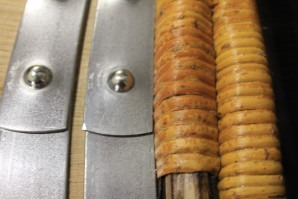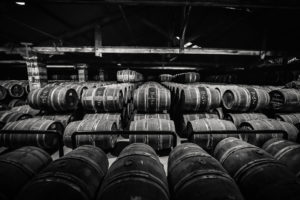Often, we can hear that some wines, especially Bordeaux wines, are ‘wooden wines’… What can I answer ? Well, I will say that even if some Châteaux are using and re-using over toasted new barrels to add body to the wine, the barrels aging can also be a good thing. It will add flavors and a nice velvet.
The goal of my article, a little bit technical, is to talk about aromas which are the result of this barrels aging. Some aromas are existing in the wood naturally but in a very very low quantity. The toast is revealing this aromas and the doses are varying thanks to the wood origin : french oak or American oak.
“Drink wine, it’s eternal life“.

Before talking of molecules, I would like to come back on the word “woody” which includes 3 aromas families : woody, resin & conifers and balsamic. It’s important to understand the differences in order to recognize the aromas during the tasting.
The woody comes from the wooden dry. The molecules are from the barrels small staves which dried during few months. This is a hot notes, dried, dusty… This note is describe like ‘wooden juice’, sawdust, wooden ships, pencil peel.
The resin & conifersnote is the one you smell when you cut a tree. Fresh, it’s the aroma of sap, turpentine, polish or green wood. This note is the one of conifers too : it’s the European and north American olfactiv culture.
Be careful, some exotic resins have hot, gourmand, syrupy, alimentary smells like caramel, vanilla or spices. These are resins you can find in South America or in Middle-East like Peru balm or Benzoin. Then, we are talking about balsamic. The balsamic aromas are often present after a barrels aging et are the one which are adding smooth.

Check point of the different molecules thanks to the barrels aging : here is a little list.
– Whiskey Lactone : The oak has 4 enantiomers. 2 geometrical isomers and 2 optical isomers which are the Trans-Whisky-Lactone and the Cis-Whisky-Lactone. The isomer Cis is more powerful than the Trans one. The whiskey lactone is bringing coconut flavors, also mushroom, celeriac and even a bitter taste when the concentration is really high. The whiskey lactone is in a huge quantity in the American oak (90% of Cis) and also in the french oak but not at all in the common oak.
– Eugenol : This molecule has got a clove flavor or dental antiseptic. This volatile phenol is appearing when the wood is dry. The light toast of the barrel is increasing this molecule.
– Isoeugenol : Formed during the toast of the barrel, this molecule can be found also in basilica, oregano or the Tolu balm. Isoeugenol has a clove flavor.
– Vanillin : The middle toast releases the biggest quantity of vanillin and the concentration decreases with a high toast. Nice, the smell is vanilla, pastry. It will even evok sugar-coated almond, biscuits, cookies, nougat and vanilla ice cream. We find this molecule in vanilla pod, coffee, cork and rum.
– Guaiacol : This molecule appears with a heavy toast and has a pharmaceutical, clove or smoky smell. We can find naturally the molecule in cocoa, coffee, pop-corn and tobacco.
– 4-Methyl-Guaiacol : This volatil phenol appears also after a very heavy toast and has a smoky, leather, clove and vanilla smells. This molecule exists naturally in malt, tea, rum, sherry or vanilla.
– Furfuryl Mercaptan : Often identified in Champagne, Petit Manseng, Semillon and barrels aged red wines, this molecule has a coffee, toasted bred, roasted and even burnt smells.
– Furanéol : We find this molecule in Banyuls wines, Portos and over-ripped Merlots but also in the barrels toast. It reminds caramel, cooked strawberry, cotton candy and even pineapple. Furaneol is naturally in maple syrup… It’s a nice molecule.
– Maltol : Strawberry jam, cotton candy, caramel, toasted bred… We find often Maltol in Chardonnay after an aging with new barrels.
– Cycloten : This molecule has got a toasted smell but also licorice, tar even if this molecule is ‘gourmand’.
– Furfural : We can find this molecule in sweet natural wines like Porto, Banyuls or oxydated wines. Furfural is also in rotten grapes (Botrytis Cinerea) and in barrels after the toast. The smell reminds sweet almond, grilled almond and caramel. We find naturally this molecule in raspberry, cranberry, black tea and whisky.
– 5-Méthyl-2-Furfural : This furanic aldehyde is formed with the toast of the barrel and brings a sweet side, butterscotch, caramel and grilled almond to the wine.
– Hydroxyméthyl-5-Furfural : The toast of logs, granules or chips will liberate this molecule in wine. Its smell is close to the previous one.
– 5-Ethoxyméthylfurfural : This molecule is in sweet natural wines and will appear during the barrels aging especially. The smell is like cinnamon and grilled almond.
– Thiophene-2-thiol : Often in Champagne or wines with a acidic pH, this thiol has got a roasted smell. With a high concentration, the molecule gives rubber or burnt plastic smells. In the contrary, with a low concentration, the smell is the one of fresh milled coffee.
– Syringol : Formed during the barrels toast, this volatil phenol has got smells of ink, Band-Aid, spices or even plastic bag !!
– Trans-2-nonénal : This molecule is a wine’s defect. It appears when the wood which is used was green or badly dried. With a vegetal smell, this molecule is responsible of the famous ‘wooden taste’. Green bug, board, dust, greasy, oily and even cucumber. If you recognize this smell, then it’s this molecule. It’s naturally in cucumber, grilled sesame seeds, watermelon, asparagus and even artichoke.
– Méta : Naturally in coal, roasted coffee and myrrh, this molecule has got a bitumen, soot or burnt plastic smells. It appears when the toast of the barrel is high.

Now you know everything about the molecules in the wood, you will dream about it !! Don’t forget that all these smells or flavors are not nice for everyone. Some people prefer fruity wines, some others woody flavors or both…



